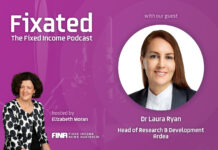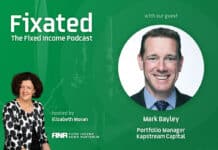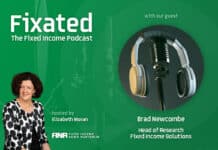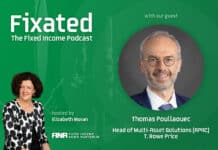
FINA’s Fixed Income ETF Finder has been updated. Here, editorial director, Elizabeth Moran summarises the changes, including new ETFs, inflows, and the best and worst performers.
Our Fixed Income ETF Finder has been updated. It lists 85 ETFs, up by a staggering 19 funds or 29% in just over 12 months. The vast majority of funds are low-risk investment grade, and many have more than 50% allocated to government bonds.
There is an ETF, or a mix of ETFs, for every investor. The market is attracting new entrants and this year the list includes:
- Coolabah Capital
- IAM
- JP Morgan
- Macquarie
- Pimco
There are new funds from Blackrock, Global X, Janus Henderson, and Schroders.
Trump tariffs have upended the market and if you’ve sold down your equities or other high risk investments, and have cash flowing into your account, consider one of the low risk, defensive ETFs on the ETF Finder.
Here are some of the most interesting things I learned from the revised list:
- Total FUM from the 85 ETFs on the finder is $34.62 billion. Note that the Finder has data month-end dates ranging from 31 December 2024 until 31 March 2025.
- BetaShares Australian High Interest Cash ETF (ASX:AAA) took the crown as the largest ETF with $4.2 billion in funds under management (FUM) to 31 December 2024, up a huge 49% over the previous reported year. Institutional investors use this ETF to access higher returns for deposits than what they would be able to achieve as a stand-alone entity. Personal investors are typically offered better deposit rates compared to institutional investors as they are considered more ‘sticky’.
- There were other very significant inflows to existing funds, including:
- VanEck Vectors Australian Subordinated Debt ETF (ASX:SUBD) came close to doubling in size, increasing by 92.5% to $2.31 billion. Subordinated debt was highly sought after in 2024, and new issues continue to be oversubscribed. So, it’s not surprising to see large inflows into this established fund.
- Vanguard Global Aggregate Bond Index (Hedged) Fund ETF (ASX:VBND) saw inflows of $1 billion to 31 December 2024 for a total FUM of $2.19 billion, up 84%. The fund has 64% invested in treasuries and government-related bonds, with a 23% corporate bond allocation and 13% in securitised assets.
- Vanguard Australian Fixed Interest Index ETF (ASX:VAF) FUM increased by 24% to $2.33 billion. This ETF is very low risk with a 90% allocation to treasuries and government-related bonds. The portfolio was rated AA+ at 31 December 2024.
- BetaShares Australian Bank Senior Floating Rate Note ETF (ASX:QPON) grew by $410m or 34% to $1.63 billion.
- BetaShares Investment Grade Corporate Bond ETF (ASX:CRED) also had more than $400m in inflows taking its FUM to $1.07 billion at 31 December 2024.
Also read: Fixed Income ETF Listings Jump to Meet Investor Demand
- A large ETF, the BetaShares Active Australian Hybrids ETF (ASX:HRBD) which was formed to invest principally in Australian listed hybrids, but capable of investing in other assets if the hybrids were deemed expensive, did just that. The fund manager pivoted in favor of subordinated debt away from hybrids. Subordinated debt made up 51.3% of the portfolio as at 31 January 2025 and hybrids 29.6%.
- Income Asset Management, new to the Finder list, came to the market with two single bond investments as ETFs.
- IAM CBA 6.46% 25/10/2033 FLOATING BOND ETF (Cboe:ETB01L) investing in a single subordinated Commonwealth Bank bond
- IAM WBC 7.199% 15/11/2038 Fixed to Floating Bond ETF (Cboe:ETB01F) investing in a single subordinated Westpac Bank bond.
- Many funds earned 7-9% over one year. The three top performers were:
- VanEck 1-3 Month US Treasury Bond ETF (ASX:TBIL), which invests in a portfolio of US dollar-denominated Treasury Bills issued by the US Government with a maturity ranging from 1-3 months, with an 11.34% return to 31 January 2025.
- Elstree Hybrid Fund (Cboe:EHFI), investing in hybrids, with a 9.9% return to 31 January 2025.
- BetaShares Interest Rate Hedged Australian Investment Grade Corporate Bond ETF (ASX:HCRD), which invests in investment grade corporate bonds and uses bond futures to substantially reduce interest rate risk. It earned 9.28% also for the year to 31 January 2025.
- Only a handful of funds had negative returns. The worst three were:
- BetaShares U.S. Treasury Bond 20+ Year ETF – Currency Hedged ETF (ASX:GGOV) with a -6.9% return. This fund takes a lot of interest rate risk and in the year to 31 January 2025, yields on long-dated US Treasury bonds increased and prices decreased.
- BetaShares Geared Long U.S. Treasury Bond Fund – Currency Hedged (Hedge Fund) (ASX:GGFD), again a long-dated US Treasury bond fund, that can borrow, which exacerbates gains and losses, with a -1.76% return.
- BetaShares Geared Long Australian Government Bond Fund (Hedge Fund) ETF (ASX:GGAB), an Australian version of the long-dated ETF above, earning -0.63%.
To find out more about fixed income ETFs, please explore the ETF Finder.
Note: None of the ETFs mentioned above are recommendations and past returns are no indication of the future.





























